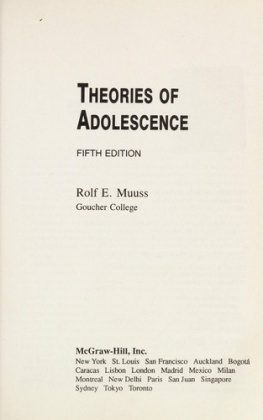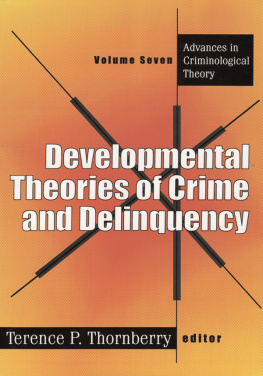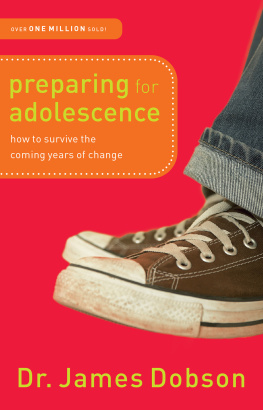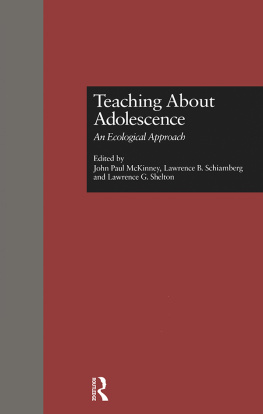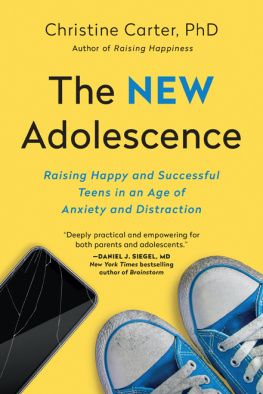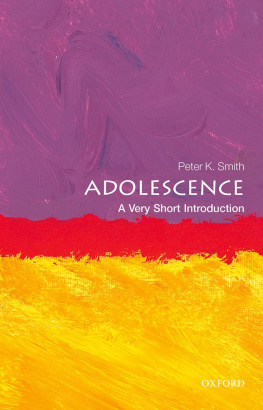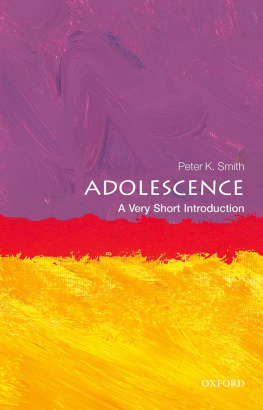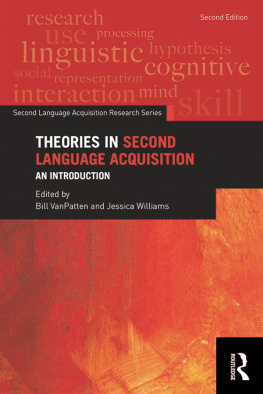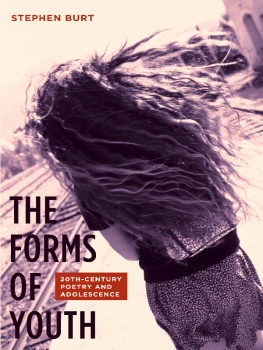Rolf Eduard Helmut Muuss - Theories of Adolescence
Here you can read online Rolf Eduard Helmut Muuss - Theories of Adolescence full text of the book (entire story) in english for free. Download pdf and epub, get meaning, cover and reviews about this ebook. year: 1988, publisher: Mcgraw-Hill College, genre: Home and family. Description of the work, (preface) as well as reviews are available. Best literature library LitArk.com created for fans of good reading and offers a wide selection of genres:
Romance novel
Science fiction
Adventure
Detective
Science
History
Home and family
Prose
Art
Politics
Computer
Non-fiction
Religion
Business
Children
Humor
Choose a favorite category and find really read worthwhile books. Enjoy immersion in the world of imagination, feel the emotions of the characters or learn something new for yourself, make an fascinating discovery.
- Book:Theories of Adolescence
- Author:
- Publisher:Mcgraw-Hill College
- Genre:
- Year:1988
- Rating:5 / 5
- Favourites:Add to favourites
- Your mark:
- 100
- 1
- 2
- 3
- 4
- 5
Theories of Adolescence: summary, description and annotation
We offer to read an annotation, description, summary or preface (depends on what the author of the book "Theories of Adolescence" wrote himself). If you haven't found the necessary information about the book — write in the comments, we will try to find it.
Theories of Adolescence — read online for free the complete book (whole text) full work
Below is the text of the book, divided by pages. System saving the place of the last page read, allows you to conveniently read the book "Theories of Adolescence" online for free, without having to search again every time where you left off. Put a bookmark, and you can go to the page where you finished reading at any time.
Font size:
Interval:
Bookmark:
Behavior Disorders
By Herb Marlow, Ph.D.
Copyright 2011 by Herb Marlow
Cover Copyright 2011 by Dara England and Untreed Reads Publishing
The author is hereby established as the sole holder of the copyright. Either the publisher (Untreed Reads) or author may enforce copyrights to the fullest extent.
First print edition published by Four Seasons Books, Inc.
This ebook is licensed for your personal enjoyment only. This ebook may not be resold, reproduced or transmitted by any means in any form, or given away to other people without specific permission from the author and/or publisher. If you would like to share this book with another person, please purchase an additional copy for each person you share it with. If youre reading this book and did not purchase it, or it was not purchased for your use only, then please return to your ebook retailer and purchase your own copy. Thank you for respecting the hard work of this author.
http://www.untreedreads.com
Behavior Disorders
A Guide for Teachers & Parents
A practical guide for teachers and parents of children with Oppositional Defiant Disorder and Conduct Disorder
Contents
This book is not written as a professional journalthough counseling professionals will certainly appreciate the practical application of therapy techniques found in its pages. It is what it proclaims to be: A guidebook for teachers and parents who deal with children on an everyday basis who have problems with Behavior Disorders; specifically, Oppositional Defiant Disorder and Conduct Disorder.
Rather than attempt to give long, professional dissertations on ODD and Conduct Disorder, this book will address symptoms and solutions, ideas and results, situations and practical applications.
Teachers and parents today constantly feel the effects of children with behavior and conduct disorders. The behavior and conduct problems discussed in this book are listed in the American Psychiatric Associations Diagnostic and Statistical Manual for Mental Disorders, Fourth Edition (American Psychiatric Association, Washington, DC, 1994) under the titles: OPPOSITIONAL DEFIANT DISORDER and CONDUCT DISORDER. Though these two disorders have overlapping symptoms, they will be considered as separate problems. Oppositional Defiant Disorder is the most common problem teachers and parents are confronted with on a regular basis.
Working together, teachers and parents try to solve the problems found in children with Oppositional Defiant Disorder and Conduct Disorder, but often guidelines and practical, workable procedures are not available to help them. This book is written as a guidebook for teachers and parents to help them help the children who are so important to all of us.
Our society contributes to the problems that our children display. As a people, we have become very selfish and hedonistic. In other words, as a society, we are out of control! Perhaps this work will help usand our childrenregain the behavioral control necessary to make all of our lives more peaceful and rewarding.
DSM-IV Diagnostic Criteria for Oppositional Defiant Disorder (ODD)
Since the late 1950s, parents have been harangued and confused by child-rearing gurus who have given many different and conflicting views of how to raise well-adjusted children. Today, our society suffers from a breakdown in discipline and respect that can be traced to those often-undisciplined writers and speakers, and their disciples.
Of course, not all behavior problems can be laid at the feet of parents who are confused about how to discipline their children. Because in our present culture the structure of accepted behavior norms has been overturned, even children raised in an atmosphere of discipline and respect will often rebel and display all of the negative behavior traits that their undisciplined peers do. The difference is, children raised in a disciplined home will know when they are doing a wrong thing, and they will expect punishment for their behavior.
A short historical view of the American social revolution of the 1960s points to where the breakdown in family values began. In most revolutions, the revolutionaries have a developed program with which they want to replace the existing or established one. Not so with our social revolution. While the revolutionaries wanted to overturn the established rules of individual, family and social behavior, they had no structure in mind to use as a model for the new way. The result was chaosa chaos that we are only now beginning to overcome. Children born during the decades of the 1960s, 1970s, 1980s and the 1990s, and on into the twenty-first century have been, and will continue to be, exposed to the uncertainties about child care and discipline found in their parents.
Often, minor behavior problems in a very young child that are not addressed and/or corrected become major ones as he grows older. When the child reaches the teen years, those major problems can become catastrophic. As can be seen by the DSM-IV excerpts, Oppositional Defiant Disorder may often be the precursor to Conduct Disorder in mid to late teen years, and Conduct Disorder is often the gateway to Antisocial Personality Disorder in adulthood. Thus, it is very important that behavior problems in a young child be corrected at an early age.
While the DSM-IV does not list specific criteria for behavior disorder (only 312.9: Disruptive Behavior Disorder Not Otherwise Specified is listed, with no real diagnostic criteria), usually the diagnosis of Oppositional Defiant Disorder (313.81) is used by professionals to design treatment plans for children with negative behavior disorders of a lesser degree of violence than Conduct Disorder. The following is an excerpt lifted from the Diagnostic and Statistical Manual of Mental Disorders, Fourth Edition, (DSM-IV) published by the American Psychiatric Association.
Please forgive the professional jargon. I am lifting this section directly from the DSM-IV and have not made any changes, except where noted. For emphasis, I have boldfaced certain portions of the excerpt.
313.81 Oppositional Defiant Disorder
Diagnostic Features
The essential feature of Oppositional Defiant Disorder is a recurrent pattern of negativistic, defiant, disobedient, and hostile behavior toward authority figures that persists for at least 6 months (Criterion A) and is characterized by the frequent occurrence of at least four of the following behaviors: losing temper (Criterion A1), arguing with adults (Criterion A2), actively defying or refusing to comply with the requests or rules of adults (Criterion A3), deliberately doing things that will annoy other people (Criterion A4), blaming others for his or her own mistakes or misbehavior, (Criterion A5), being touchy or easily annoyed by others (Criterion A6), being angry and resentful (Criterion A7), or being spiteful or vindictive (Criterion A8). To qualify for Oppositional Defiant Disorder, the behaviors must occur more frequently than is typically observed in individuals of comparable age and development level, and must lead to significant impairment in social, academic, or occupational functioning (Criterion B). The diagnosis is not made if the disturbance in behavior occurs exclusively during the course of a Psychotic or Mood Disorder (Criterion C), or if criteria are met for Conduct Disorder or Antisocial Personality Disorder (in an individual over 18 years).
Negative and defiant behaviors are expressed by persistent stubbornness, resistance to directions, and unwillingness to compromise, give in, or negotiate with adults or peers. Defiance may also include deliberate or persistent testing of limits, usually by ignoring orders, arguing, and failing to accept blame for misdeeds. Hostility can be directed at adults or peers, and is shown by deliberately annoying others or by verbal aggression (usually without the more serious physical aggression seen in Conduct Disorder). Manifestations of the disorder are almost invariably present in the home setting, but may not be evident at school or in the community. Symptoms of the disorder are typically more evident in interactions with adults or peers whom the individual knows well, and thus may not be apparent during clinical examination.
Font size:
Interval:
Bookmark:
Similar books «Theories of Adolescence»
Look at similar books to Theories of Adolescence. We have selected literature similar in name and meaning in the hope of providing readers with more options to find new, interesting, not yet read works.
Discussion, reviews of the book Theories of Adolescence and just readers' own opinions. Leave your comments, write what you think about the work, its meaning or the main characters. Specify what exactly you liked and what you didn't like, and why you think so.

